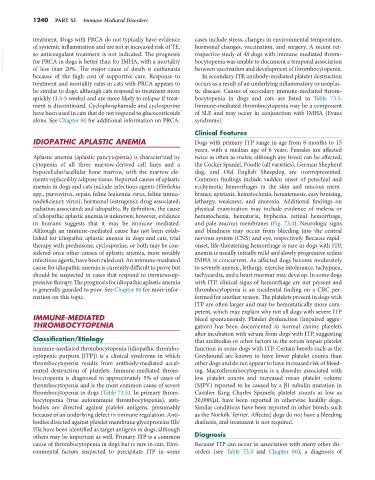Page 1268 - Small Animal Internal Medicine, 6th Edition
P. 1268
1240 PART XI Immune-Mediated Disorders
treatment. Dogs with PRCA do not typically have evidence cases include stress, changes in environmental temperature,
of systemic inflammation and are not at increased risk of TE, hormonal changes, vaccination, and surgery. A recent ret-
VetBooks.ir so anticoagulant treatment is not indicated. The prognosis rospective study of 48 dogs with immune mediated throm-
bocytopenia was unable to document a temporal association
for PRCA in dogs is better than for IMHA, with a mortality
of less than 20%. The major cause of death is euthanasia
In secondary ITP, antibody-mediated platelet destruction
because of the high cost of supportive care. Response to between vaccination and development of thrombocytopenia.
treatment and mortality rates in cats with PRCA appears to occurs as a result of an underlying inflammatory or neoplas-
be similar to dogs, although cats respond to treatment more tic disease. Causes of secondary immune-mediated throm-
quickly (1.5-5 weeks) and are more likely to relapse if treat- bocytopenia in dogs and cats are listed in Table 73.5.
ment is discontinued. Cyclophosphamide and cyclosporine Immune-mediated thrombocytopenia may be a component
have been used in cats that do not respond to glucocorticoids of SLE and may occur in conjunction with IMHA (Evans
alone. See Chapter 80 for additional information on PRCA. syndrome).
Clinical Features
IDIOPATHIC APLASTIC ANEMIA Dogs with primary ITP range in age from 8 months to 15
years, with a median age of 6 years. Females are affected
Aplastic anemia (aplastic pancytopenia) is characterized by twice as often as males; although any breed can be affected,
cytopenia of all three marrow-derived cell lines and a the Cocker Spaniel, Poodle (all varieties), German Shepherd
hypocellular/acellular bone marrow, with the marrow ele- dog, and Old English Sheepdog are overrepresented.
ments replaced by adipose tissue. Reported causes of aplastic Common findings include sudden onset of petechial and
anemia in dogs and cats include infectious agents (Ehrlichia ecchymotic hemorrhages in the skin and mucous mem-
spp., parvovirus, sepsis, feline leukemia virus, feline immu- branes, epistaxis, hematochezia, hematemesis, easy bruising,
nodeficiency virus); hormonal (estrogens); drug associated; lethargy, weakness, and anorexia. Additional findings on
radiation associated; and idiopathic. By definition, the cause physical examination may include evidence of melena or
of idiopathic aplastic anemia is unknown; however, evidence hematochezia, hematuria, hyphema, retinal hemorrhage,
in humans suggests that it may be immune mediated. and pale mucous membranes (Fig. 73.4). Neurologic signs
Although an immune-mediated cause has not been estab- and blindness may occur from bleeding into the central
lished for idiopathic aplastic anemia in dogs and cats, trial nervous system (CNS) and eye, respectively. Because rapid-
therapy with prednisone, cyclosporine, or both may be con- onset, life-threatening hemorrhage is rare in dogs with ITP,
sidered once other causes of aplastic anemia, most notably anemia is usually initially mild and slowly progressive unless
infectious agents, have been ruled out. An immune-mediated IMHA is concurrent. As affected dogs become moderately
cause for idiopathic anemia is currently difficult to prove but to severely anemic, lethargy, exercise intolerance, tachypnea,
should be suspected in cases that respond to immunosup- tachycardia, and a heart murmur may develop. In some dogs
pressive therapy. The prognosis for idiopathic aplastic anemia with ITP, clinical signs of hemorrhage are not present and
is generally guarded to poor. See Chapter 86 for more infor- thrombocytopenia is an incidental finding on a CBC per-
mation on this topic. formed for another reason. The platelets present in dogs with
ITP are often larger and may be hemostatically more com-
petent, which may explain why not all dogs with severe ITP
IMMUNE-MEDIATED bleed spontaneously. Platelet dysfunction (impaired aggre-
THROMBOCYTOPENIA gation) has been documented in normal canine platelets
after incubation with serum from dogs with ITP, suggesting
Classification/Etiology that antibodies or other factors in the serum impair platelet
Immune-mediated thrombocytopenia (idiopathic thrombo- function in some dogs with ITP. Certain breeds such as the
cytopenic purpura [ITP]) is a clinical syndrome in which Greyhound are known to have lower platelet counts than
thrombocytopenia results from antibody-mediated accel- other dogs and do not appear to have increased risk of bleed-
erated destruction of platelets. Immune-mediated throm- ing. Macrothrombocytopenia is a disorder associated with
bocytopenia is diagnosed in approximately 5% of cases of low platelet counts and increased mean platelet volume
thrombocytopenia and is the most common cause of severe (MPV) reported to be caused by a β1-tubulin mutation in
thrombocytopenia in dogs (Table 73.5). In primary throm- Cavalier King Charles Spaniels; platelet counts as low as
bocytopenia (true autoimmune thrombocytopenia), anti- 30,000/µL have been reported in otherwise healthy dogs.
bodies are directed against platelet antigens, presumably Similar conditions have been reported in other breeds such
because of an underlying defect in immune regulation. Anti- as the Norfolk Terrier. Affected dogs do not have a bleeding
bodies directed against platelet membrane glycoproteins IIb/ diathesis, and treatment is not required.
IIIa have been identified as target antigens in dogs, although
others may be important as well. Primary ITP is a common Diagnosis
cause of thrombocytopenia in dogs but is rare in cats. Envi- Because ITP can occur in association with many other dis-
ronmental factors suspected to precipitate ITP in some orders (see Table 73.5 and Chapter 86), a diagnosis of

